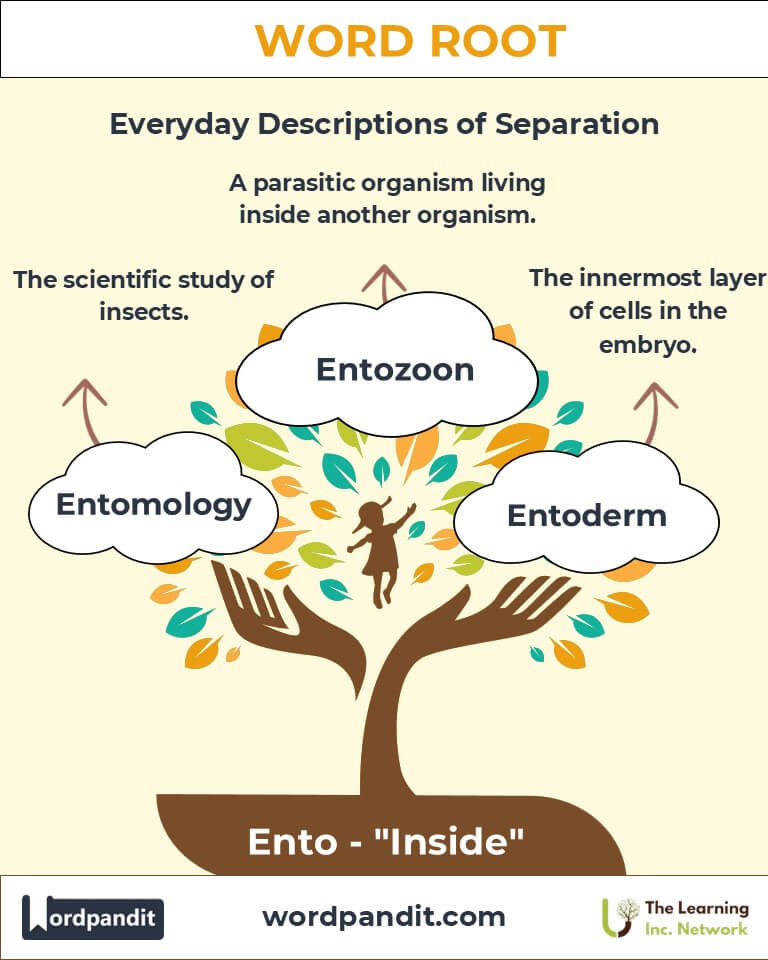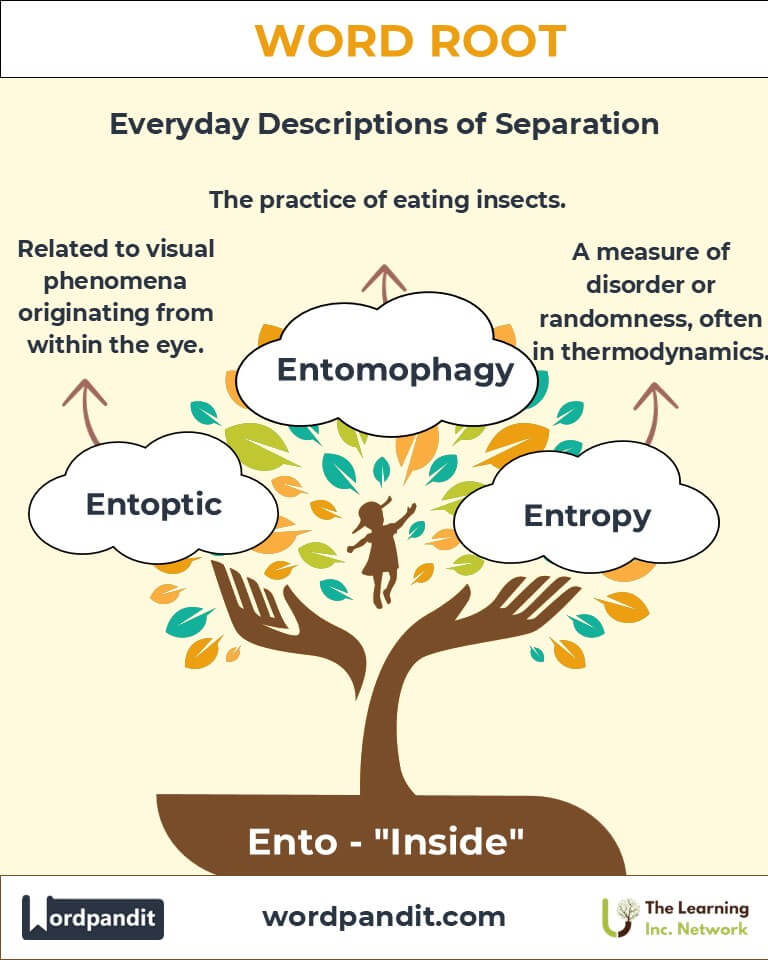Ento: Exploring the Inner World of Insects and Beyond
Discover the fascinating roots of "Ento," derived from the Greek word entos, meaning "within" or "inner." From the world of insects to scientific disciplines, "Ento" opens a gateway to understanding life forms and inner spaces.

Table of Contents
- Introduction: The Essence of "Ento"
- Etymology and Historical Journey
- Mnemonic: Unlocking the Power of "Ento"
- Common "Ento"-Related Terms
- "Ento" Through Time
- "Ento" in Specialized Fields
- Illustrative Story: "Ento" in Action
- Cultural Significance of the "Ento" Root
- The "Ento" Family Tree
- FAQs about the "Ento" Word Root
- Test Your Knowledge: "Ento" Mastery Quiz
- Conclusion: The Living Legacy of "Ento"
Introduction: The Essence of "Ento"
Have you ever wondered what goes on within the intricate world of insects or how we understand the inner workings of life? The word root "Ento" (pronounced en-toh), meaning "within" or "inner," provides a linguistic and conceptual framework for exploring everything from entomology (the study of insects) to sciences delving into internal structures. With its origins in Greek, "Ento" enriches our understanding of microcosmic and hidden layers of life.

Etymology and Historical Journey
The root "Ento" originates from the Greek word entos, meaning "within" or "inside." It first gained prominence in scientific language during the 18th century, as entomology developed into a formal field of study. Over time, "Ento" expanded into other disciplines, emphasizing exploration of internal systems or confined spaces.
Mnemonic: Unlocking the Power of "Ento"
To remember "Ento," visualize a magnifying glass examining the inner workings of a beehive, uncovering the secrets hidden within.
Mnemonic Device: "Ento leads you inside the intricate web of life."
Common "Ento"-Related Terms
- Entomology (en-tuh-mol-uh-jee): The scientific study of insects.
Example: "Her passion for butterflies led her to pursue a career in entomology." - Entophyte (en-toh-fite): A plant or fungus growing inside another plant.
Example: "Entophytes can play a role in protecting plants from pests." - Entozoa (en-toh-zoh-uh): Internal parasites, especially worms living within an animal's body.
Example: "Veterinarians often deal with entozoa affecting livestock." - Entoblast (en-toh-blast): The innermost layer of cells in an embryo, forming the digestive tract.
Example: "The entoblast is crucial for the development of vital organs." - Entocentric (en-toh-sen-trik): Focused on the inner aspects of a system or structure.
Example: "His research took an entocentric approach to cellular biology."
"Ento" Through Time
- Entomology: One of the earliest fields to adopt "Ento," it emerged in the 18th century with the study of insect anatomy and behavior.
- Entophytes: This term gained relevance in botany and ecology in the 20th century, emphasizing symbiotic relationships.
- Entoblast: Used in embryology to describe critical early stages of development.
"Ento" in Specialized Fields
- Biology: Terms like entophyte and entozoa highlight "Ento's" significance in studying life processes.
- Medicine: Understanding entozoa is critical in diagnosing and treating parasitic infections.
- Environmental Science: The study of entophytes provides insights into sustainable agriculture and plant health.
Illustrative Story: "Ento" in Action
Dr. Sophia Alvarez, an entomologist, was fascinated by the inner social structures of ants. Her groundbreaking research revealed how ants use pheromones to communicate within their colonies, demonstrating an intricate inner network of teamwork and efficiency. Inspired by her findings, Sophia applied these principles to optimize urban traffic systems, proving that even the smallest "Ento" worlds can impact the broader human experience.
Cultural Significance of the "Ento" Root
The concept of exploring inner spaces resonates across cultures. From ancient Greek philosophies of introspection to modern scientific discoveries, "Ento" embodies the quest to understand the unseen. Entomology, in particular, has influenced art, literature, and environmental activism, encouraging a deeper appreciation for the interconnectedness of life.

The "Ento" Family Tree
Related Roots:
- Endo- (inside): Found in terms like endoskeleton (an internal skeleton).
- Intra- (within): Seen in intravenous (within a vein).
- Inter- (between): Referring to connections, like intercellular (between cells).

FAQs About the Ento Word Root
Q: What does "Ento" mean?
A: "Ento" means "within" or "inner," derived from the Greek word entos. It conveys the idea of internal structures, confined spaces, or hidden systems in scientific and other contexts.
Q: How is "Ento" used in scientific language?
A: In biology and medicine, "Ento" appears in terms like entomology (study of insects), entozoa (internal parasites), and entoblast (inner cell layers in embryos). It emphasizes the exploration of internal or enclosed systems.
Q: What is entomology, and why is it important?
A: Entomology is the scientific study of insects. This field is vital because insects play crucial roles in ecosystems, such as pollination, decomposition, and serving as food for other organisms. They also impact agriculture, health, and biodiversity.
Q: What are entophytes, and why are they significant?
A: Entophytes are plants or fungi that grow inside another plant. They can enhance the host plant’s resistance to pests or environmental stress, contributing to sustainable agricultural practices.
Q: What are entozoa?
A: Entozoa are internal parasites, like worms or protozoa, that live within an animal's body. Understanding entozoa is essential for diagnosing and treating parasitic diseases in humans and animals.
Q: Can "Ento" be used metaphorically?
A: While primarily scientific, "Ento" can metaphorically represent exploration of hidden or inner aspects, such as delving into a person's inner thoughts or feelings.
Test Your Knowledge: Ento Mastery Quiz
1. What does the root "Ento" mean?
2. What is entomology?
3. Which term describes internal parasites?
4. What is the focus of an entocentric approach?
Conclusion: The Living Legacy of "Ento"
The root "Ento" symbolizes humanity's relentless curiosity about what lies within. From the minute world of insects to the depths of human cells, it challenges us to uncover hidden complexities. As science and culture continue to evolve, "Ento" reminds us that exploring the inner world can lead to profound discoveries, shaping our understanding of life itself.












